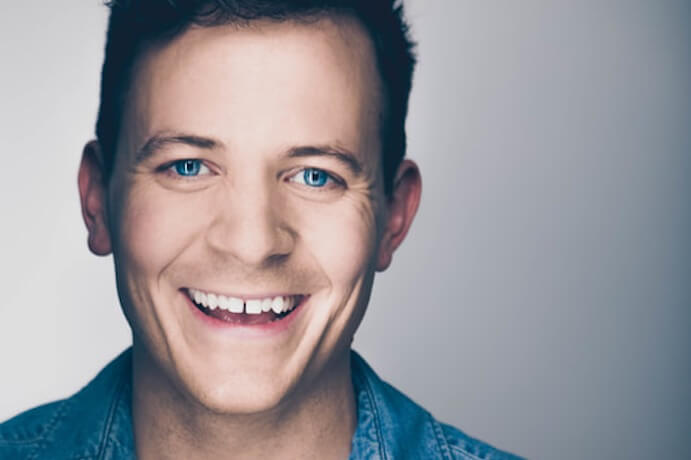Richard Valitutto is a GRAMMY-nominated pianist based out of L.A. With a focus mostly on contemporary repertoire, Valitutto has become a champion of new concert music as a soloist, collaborator, and member of the modern music collective Wild Up. His latest album, nocturnes & lullabies (New Focus Recordings), is a solo project based on the resonant properties of the piano and the idea of a new virtuosity, or as Valitutto puts it, “anti-virtuosity.” The project features composers Nicholas Deyoe, Rebecca Saunders, Philip Cashian, Marc Sabat, Maura Capuzzo, Wolfgang von Schweinitz, and Linda Catlin Smith, with seven of the eight tracks being world premiere recordings.
The album starts off with Nicholas Deyoe’s NCTRN, a dark piece the uses tonal clusters and long sustains throughout. The percussive strike of broken bells starts to interject, disrupting the hazy suspensions and rapid sputtering figures that make up most of this sound world. Eventually, the bells take over and become the presiding idea by the end of the piece. Valitutto makes NCTRN sound easy, lending an almost improvised feeling to it.
Rebecca Saunders‘ shadow is aggressive and harsh by comparison. Quick and loud tonal clusters open the track, sounding almost random and freely dispersed. In between the bursts are quietly suspended sympathetic vibrations that shimmer as they decay, achieved through a combination of pedal work and silently depressing keys while violently striking others. These “acoustic shadows,” as described by the composer, draw the listener in and make the flurry of attacks that produce them that much more powerful. Valitutto’s mastery and control in producing these effects is impressive.

Nocturne is one of Philip Cashian’s early works, which shifts gears yet again to a different listening experience. Cashian’s sound world meanders through different gestures and registers, while continually pulling the listener through a dense fog. It’s quite beautiful and has a dark foreboding feel to it. Similarly, Marc Sabat’s Nocturne is quiet and meditative. Described by the composer as “a study of metric modulations in slow tempo,” Sabat’s Nocturne presents different ideas over the course of the track, each one unvaried and unyielding in establishing its own time and tempo. With this demand, Valitutto’s touch, focus, and care is remarkable.
With one of the pedals used as a percussion instrument and the strumming of the strings inside the piano, Portami con te nel mattino vivace by Maura Capuzzo is a piece that encourages what most piano teachers do not. This work plods along slowly, using the upper range of the piano almost exclusively. Capuzzo’s writing is hypnotic and draws the listener in continually. Wolfgang von Schweinitz’s Plainsound Lullaby, Op. 59 puts Valitutto’s hands inside the piano, as well. Using mostly accented and suspended multiphonics from the bass strings of the piano, the resulting “chords” have an ethereal beauty to them. Very few times does Schweinitz move away from these harmonics, but when it happens, the effect is further intensified.
Commissioned and dedicated to Eve Egoyan, A Nocturne by Linda Catlin Smith is subtle, ambiguous, and quietly powerful. The work is mainly comprised of a polytonal collection of major and minor chords floating through the air. A single E-flat becomes the constant obsession of the piece. There is a delicate and fragile air that is constructed throughout the work. Eventually thick, complex chords build up and break the trance before bringing the energy back down. Valitutto’s ability to direct aural drama is on full display in this track.

Lullaby 2, another work by Nicholas Deyoe, bookends the album. Lullaby 2 slowly constructs itself into a dark and foreboding soundscape. Pulling quotes from the metal band Death and Schubert’s B-flat Sonata, the work revolves around the idea of death as an endless sleep. Starting with a lone tremolo at the top of the piano’s range, Deyoe is slow to add in other gestures and accompanying elements. The texture eventually grows thick and brittle before pulling back again to a low, single, repeated note that gives the sense of dying away. As if fighting for life, the tremolo from the beginning builds up violently in this low register, racing to a brutal climax. Suddenly, the Schubert quotation is played reverently, but is left unresolved.
Richard Valitutto not only does an incredible job of bringing life and dedicated care to these works, but also displays a great aptitude for programming. nocturnes & lullabies is a journey through the lyrical, exploratory, and unconventional possibilities the piano still has to offer the 21st century. The overall arc of the album helps to highlight the contrast between compositional styles while still keeping the music tied together. Valitutto is a true champion of new music, and I look forward to hearing how much further he will help push the boundaries of what is possible.
























